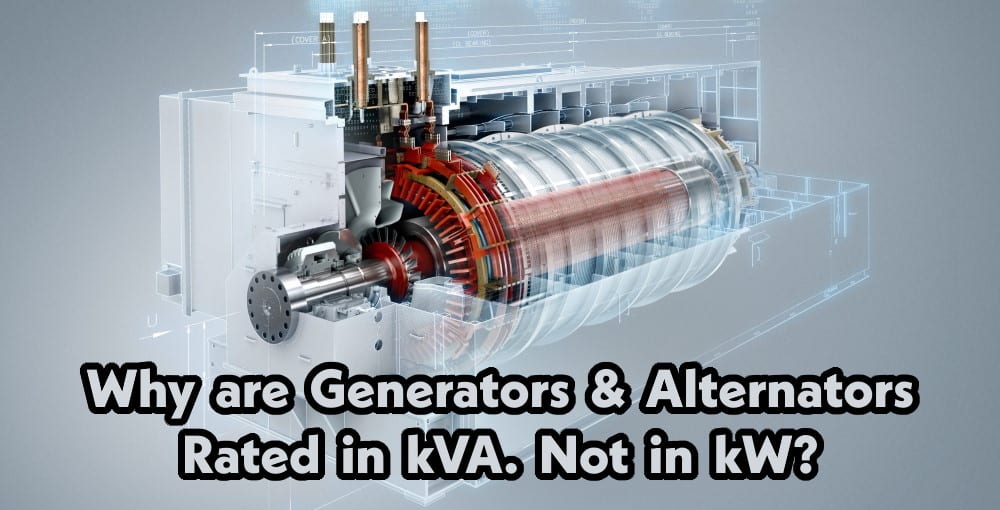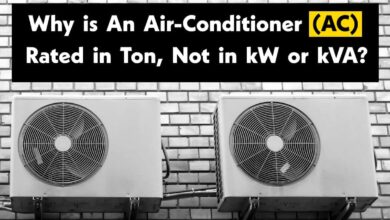Why are Generators and Alternators Rated in kVA, Not in kW?
Why is an Alternator or Generator Rated in kVA, Not in kW?
As we already know why a transformer is rated in kVA instead of kW, the same principle applies to alternators and generators. The total power delivered, given by the formula √3 VL IL Cos ϕ depends on the P.F (Power Factor = cosϕ) of the load. In other words, generators and alternators do not supply only active power (watts); they deliver both active and reactive power, which varies with the load’s power factor.
It is important to note that the conductors of an alternator are designed for a specific current, and the insulation and magnetic system are designed for a definite voltage. Both voltage and current are independent of the load’s power factor. For this reason, the rated power of an alternator is expressed as apparent power in kVA rather than in kW.
In short, a generator produces both active and reactive power, so its rating is given in volt-amperes (VA) instead of watts (W).
The main factors manufacturers consider while designing electrical devices and appliances which provide electric power like transformer, UPS, alternators and generators etc., are load and power factor. As they don’t know exactly what is the power factor and which kind of load (resistive, inductive, capacitive or a mixture of all of them) will be connected to the device and appliances.
The main factors manufacturers consider when designing electrical devices and appliances that supply electric power (such as transformers, UPS systems, alternators, and generators) are the load and the power factor. Manufacturers cannot precisely determine the power factor or the type of load (whether resistive, inductive, capacitive, or a combination of these) that will be connected.
Therefore, they design and rate the electrical device based on the maximum current the conductors can safely carry, assuming a unity power factor, as in the case of a purely resistive load.
- Related Posts: Difference Between Alternator and Generator with Comparison
If we connect inductive or capacitive load (When power factor is not at least unity), The output would differ as there are losses due to low power factor.
For this reason, KVA is an apparent power which does not take into account the PF (Power factor) instead of KW (Real Power).
Where:
KW = KVA × Cos ϕ
And
kVA = KW ÷ Cos ϕ
For example,
In case of unity Power factor (1) i.e. pure resistive load. A 100kVA generator or alternator would provide exactly 100kW according to the following formula.
P = V × I × Cos ϕ
kW = V × I × Cos ϕ
kW = 100 × 1 = 100 kW
If we put the value of Cos ϕ as 1, the real power (kW) would be equal to the apparent power (kVA).
In case of inductive or capacitive load, suppose the power factor is 0.80.
Now the real power would be:
kW = KVA × Cos Φ
kW = 100 × 0.80
kW= 80 kW.
Now you can understand why alternators, generators, transformers, UPS systems, and similar equipment are rated in kVA rather than in kW.
Related Posts:
- Why is a Transformer rated in kVA, not in kW?
- Why is a Motor rated in kW instead of kVA?
- Why is an Air-condition (AC) Rated in Ton, not kW or kVA?
- Why is a Power Plant Capacity Rated in MW and not in MVA?
- Why is a Battery rated in Ah (Ampere hour) and not in VA?
- Why was a Circuit Breaker Capacity Rated in MVA and Now in kA and kV?
- Synchronous Generator and Alternator Formulas & Equations
- Parallel Operation of DC Generators & Synchronization of Generators
- What is Motor Generator Set and How Does it Work?
- Generator and Alternator Symbols
- Alternator / Generator MCQs with Explanatory Answers)
- How to Size a Generator? Portable, Backup & Standby for Home & Commercial Applications
- How to Connect a Portable Generator to the Home Supply – 4 Methods








i environment worker
Thank you Electrical Technology for clarification.